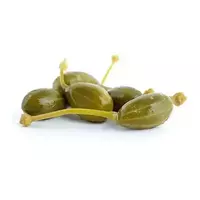Clekachka colchis (jonjoli)

Kolkhidskaya klekachka, which is often called jonjoli, can be attributed to one of the most and at the same time specific delicatessen products of Georgian cuisine. This is a rather common condiment in this country, which has a taste of capers, is used in the preparation of many dishes.
The Colchis (jonjoli) Clekachka plant itself is a small tree or shrub in the genus Clekachka. In the wild, it grows in the Caucasus, Central Asia and Crimea. The plant is characterized by naked shoots of green color with leaflets of five and brown bark, as well as oblong flower buds.
Following the spreading of leaves, which occurs in April, oblong buds of white color begin to appear, collected in racemose inflorescences. These buds have a faint but very pleasant aroma. The local population collects buds, and then pickles and alum them in a way similar to harvesting white cabbage.
To prepare a snack, colchis (jonjoli) washed and dried sprigs are laid in layers in clay or wooden containers, after which they are poured with salt. When the utensils are completely filled with greens, the contents are compacted and filled further to the edges. Wooden mugs are placed on the Colchis weed (jonjoli), on which a load is superimposed on top. Under oppression, a real Caucasian colchis (jonjoli) is left for fermentation for up to a month and a half, after which it is completely ready for use.
Typically, the finished snack is lightly squeezed before serving and then dusted with crushed green or bulb onions and topped with vegetable oil. It is customary to serve colchis (jonjoli) as a seasoning or spicy snack.
Sauerkachka colchis (jonjoli) is great with meat, fish, vegetable, first courses, as well as cold and hot sauces. In addition, as well as capers, colchis (jonjoli) can be safely served by seasoning with olive or butter, mayonnaise.
Lamb, chicken, beef, seafood, anchovies, smoked and salted fish, pasta, tomatoes, olives, sweet peppers, celery, eggs, dill and parsley, all accompanied by a clutch of colchis (jonjoli), are excellent eats.
In many countries, this food is highly valued for its unique taste, as well as for the quality that, being environmentally friendly, colchis (jonjoli) is produced without the use of chemical additives. Jonjoli enter the retail chain packaged in glass jars. However, it is important to know that in uncorked dishes this exquisite delicacy can be stored for no more than two days.
clumps of colchis (jonjoli) 23 kCal
Energy value of colchis (jonjoli) (Ratio of proteins, fats, carbohydrates - ju):
Proteins: 2.36 g (~ 9 kCal)
Fats: 0.86 g (~ 8 kCal)
Carbohydrates: 1.69 g (~ 7 kCal)
Energy ratio (b | y): 41% | 34% | 29%
 Español
Español Français
Français Português
Português Русский
Русский 简体中文
简体中文 繁體中文
繁體中文 日本語
日本語 한국어
한국어 العربية
العربية Türkçe
Türkçe Қазақ
Қазақ Deutsch
Deutsch Italiano
Italiano Українська
Українська
